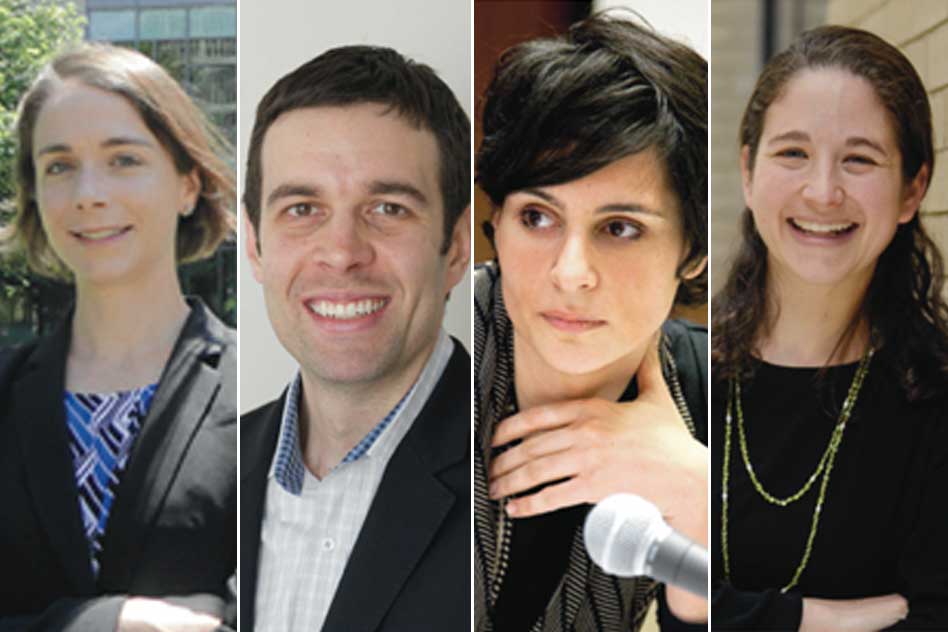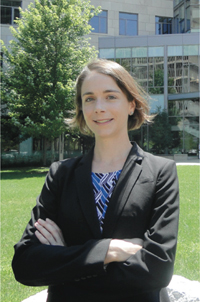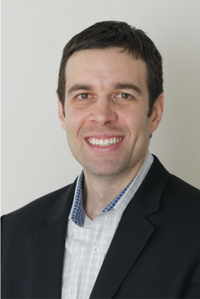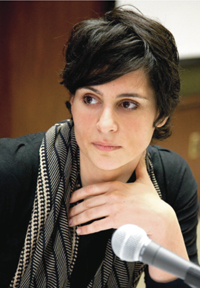
MITEI sat down with four new energy faculty to find out what brought them to MIT and what they plan on researching now that they’re here. Read about Valerie Karplus, A. John Hart, Rania Ghosn and Elsa Olivetti.

Valerie Karplus. Photo: Vicki Ekstrom, MITEI
Valerie Karplus SM ’08, PhD ’11
Assistant professor in the Sloan School of Management
Valerie Karplus can trace her interest in international energy affairs to a college course titled Science, Technology, and International Affairs. Her love of the material led the politics-biophysics double major to seek an internship with the Council on Foreign Relations and later to cofound the student-run international affairs magazine The Yale Globalist. While working on the Globalist, Karplus became particularly interested in China. She went on to win a Henry Luce Fellowship for professional study in China post-graduation, and her path took her eastward yet again when she postponed US graduate study to complete a book on China’s agricultural biotechnology industry and begin research on China’s energy system. Now, Karplus, a newly minted faculty member at MIT Sloan with a PhD in engineering systems from MIT, has found her way back to the classroom.
Talk a little about your involvement with the China Energy and Climate Project at MIT.
After finishing my PhD, I had the incredible opportunity to start a program on China within the Joint Program on the Science and Policy of Global Change—the China Energy and Climate Project, or CECP—fulfilling a vision that I’ve had since I first lived in China. Identifying pathways for transitioning to a more environmentally sustainable energy system in China requires a combination of in-country connections, deep understanding of the country’s energy system, and solid analytical approaches that can be used to support decision making. The goal behind the whole project is to develop this shared platform.
One of our CECP accomplishments thus far is the development of the Regional Emissions Air Quality Consumption and Health modeling framework, or REACH. Our research involves projecting air pollution emissions for China’s provinces under alternative energy policies in a regional energy-economic model and using these projections to simulate air quality outcomes, including ozone and particulate matter, in an atmospheric chemistry model. We can then use the regional energy-economic model to calculate health impacts under alternative scenarios and the magnitude of such damages avoided due to policy. We are currently analyzing the costs and benefits of several energy and climate policies using this framework.
How was your first teaching experience at MIT Sloan last spring?
I thoroughly enjoyed it. Application-oriented classes like my courses on global strategy [15.220 Global Strategy and Organization] and global entrepreneurship [15.395 Global Entrepreneurship Lab: Entrepreneurs Without Borders] are exciting to teach because they tackle current challenges in developing global companies that generate lively discussion and debate. I am enjoying the process of learning how to lead a case discussion, which often encourages students to reason through real-world decisions and adopt different perspectives.
You’ve made a number of decisions to stay at MIT in your career, even when career opportunities have arisen elsewhere. What have you learned from being immersed in the MIT culture?
MIT provides an ideal laboratory for combining insights from research and practice to solve real-world problems. An important underlying reason is that the MIT culture encourages the formation of dynamic, interdisciplinary teams. With good communication and effective teamwork, you can begin to characterize and tackle large, complex problems—and defining the problem can be half the battle. It is also very important to develop a team whose members really care about each other and want to see everyone on the team succeed. MIT lays the foundation for these kinds of collaborations to develop and thrive, and in the process we challenge our own thinking and test the boundaries of what is possible. It’s very exciting, and it’s what I love about MIT.

A. John Hart. Photo: Tony Pulsone, MIT
A. John Hart SM ’02, PhD ’06
Associate professor in the Department of Mechanical Engineering
A. John Hart’s research interests focus on the science and manufacturing of new materials—in particular, materials with controlled micro- and nanoscale structures—and the pursuit of innovative applications of those materials, including energy conversion and production. His arrival in summer 2013 was something of a homecoming. In the early years of his career, he was a graduate student at MIT, earning both his master’s and PhD in mechanical engineering. Prior to returning to MIT, he was an assistant professor at the University of Michigan, where in 2007 he founded the Mechanosynthesis Group (mechanosynthesis.mit.edu). Hart’s group is now based at MIT—a place where, he says, the general belief that “anything is possible” inspires him and his research team.
Your particular expertise is manufacturing. Can you tell us why manufacturing is important and what avenues you’re pursuing to improve it?
Recently, there has been a lot of important dialogue about advanced manufacturing technologies and their role in the innovation process, both domestically and globally. While industry excels at developing manufacturing technologies at impressive scales, many new materials and devices do not reach the market—or take a long time to do so—because of the challenge of scaling the manufacturing process at appropriate cost. Motivated by that problem, we largely undertake projects that combine expertise in manufacturing processes, mechanical design, and materials processing. At present, our group is working on three main themes: nanomaterials, particularly carbon nanotubes and graphene; additive manufacturing, including machines for high-speed “3D printing” of composites and metals as well as high-precision printing of electronics at small scales; and origami-inspired manufacturing using folding to transform patterned laminates into deployable structures for aerospace and medical applications.
What are some of the energy applications of your work?
We’re interested in the use of nanomaterials in energy storage. For example, we’re designing high-performance battery electrodes using some of the carbon nanomaterials that we make. Another project involves using nanomaterials to make electrostatic capacitors that can charge very quickly and can operate under extreme conditions, such as close to the engine of a vehicle or at the bottom of an oil well during exploration. We’re also creating engineered surfaces using carbon nanotube microstructures that can be useful in energy applications. These surfaces have complex 3-dimensional textures that are robust and electrically and thermally conductive—a combination that’s unusual among materials that can be patterned cost-effectively over large areas.
What classes are you teaching?
One is 2.008, the main class on manufacturing processes for mechanical engineering undergraduates. In that class, students learn the fundamentals of manufacturing processes ranging from machining and injection molding to 3D printing, and principles of variation, quality, cost, and scale-up. One class project involves working as a team to design and manufacture a yo-yo—in a quantity of 100! I also teach a new graduate course on additive manufacturing in which students learn the fundamentals of different 3D printing methods and then design an improved 3D printing machine or figure out how to print an entirely new material. Last summer, we offered a new five-day MIT Short Program on additive manufacturing. Nearly 50 participants came to MIT from all over the map, both geographically and professionally, to learn about the reality and potential of additive manufacturing to enable new capabilities for their design and manufacturing operations, ranging from product prototyping using polymers to printing of complex tooling and structural parts from metals and composites. They also asked long-range questions like, Are you going to be printing smartphones in the future, and, Will 3D printing change where manufacturing happens in the world?

Rania Ghosn. Photo: Rania Ghosn, MIT
Rania Ghosn
Assistant professor in the Department of Architecture
Rania Ghosn’s research thrives at the intersection of architecture, geography, urban studies, and energy. She is particularly interested in infrastructures built for energy purposes and how they interact with both a built cityscape and a natural landscape. Ghosn holds a doctorate in design from Harvard University, an MA in geography from University College London, and a bachelor of architecture from American University of Beirut. She was an assistant professor at the University of Michigan, teaching graduate design studios, running thesis studies on the American Corn Belt, and offering a graduate seminar on energy. Prior to that, she served as a Mellon Postdoctoral Fellow at Boston University, where she helped organize the Sawyer Seminar Series on Energy and Society. At MIT, in fall 2014 she taught 4.S26 Landscapes of Energy, a research seminar that proposes a critical spatial inquiry on the relations of energy and space to understand, critique, and ultimately influence choices regarding energy options.
How does energy relate to your work with architecture and city planning?
I use energy as a lens though which to examine how large technological systems underpin the functioning of cities and the transformation of landscapes, regions, and the globe. My work considers systems like waste management, agriculture, and highways and how they relate “hinterlands” to urban centers. Initially, I was drawn into the study of energy almost by coincidence, or geographic proximity. I was looking at one piece of larger infrastructure—a highway being planned in the Middle East—and came to realize that it was being planned to run next to an oil pipeline. My interest in that crude oil pipeline grew till it actually became the subject of my dissertation.
That pipeline is also the subject of one of your forthcoming books, correct?
Yes, there are actually two book projects. The subject of the first one is the Trans-Arabian Pipeline, which operated between 1950 and 1975. It describes how the pipeline that ran for around a thousand miles across the Middle East produced its own geographies—spaces such as pumping station towns, water wells, and health and education facilities. So the book is basically a biography of this piece of infrastructure. It looks at the geographic footprint of something that we usually think of as merely crossing through the landscape and vanishing into the horizon and seeks to unearth the multiple political, economic, and spatial transformations that were part of such an operation. The second book I’m working on, the Atlas of the Corn Belt, looks into the histories and geographies through which corn became the predominant crop—a product that is diversified for multiple industrial uses, be they food additives, livestock feed, or ethanol fuel.
What drew you to MIT?
I was drawn to the MIT School of Architecture and Planning by its interdisciplinary approach to urbanism. The newly established Center for Advanced Urbanism reinforces the significance of urban questions within the Institute as beyond the domain of a single discipline. As I mentioned, I’m very interested in these kinds of intersections, especially between architecture, geography, energy, and, more broadly, environmental questions. The fact that MIT highlights collaboration in its mission really appeals to me. It is my first semester, and I’ve found that sense of collaboration reflected in things from research centers and dissertation committees to the architecture itself. The idea of having one “infinite corridor” meant to connect all disciplines and foster teamwork was a pleasant surprise to me as a newcomer. The philosophy behind it still means a great deal to me.
Elsa Olivetti. Photo: Travis Gray, MIT
Elsa Olivetti PhD ’07
Assistant professor in the Department of Materials Science and Engineering
Elsa Olivetti’s academic pursuits merge the disciplines of materials science and energy research. Her dedication to energy conservation on MIT’s campus began when she was a graduate student in materials science and engineering. In 2006, she and fellow student Jason Jay PhD ’10 launched the MIT Generator, an ongoing annual student-driven brainstorming session on how to improve campus energy efficiency. Olivetti was also part of a research team that won one of the first MIT Energy Initiative seed grants in 2008. She joined the faculty in 2014 and now balances commitments among research, teaching, and lending her talents to MIT programs such as the Tata Center for Technology and Design, where she has been collaborating on strategies for reducing waste byproducts for industries in India.
What’s the main focus of your current research?
I conduct research on the development of materials and on the technologies that spring from those materials, both from an economic and an environmental perspective. I consider the full life cycle that necessarily goes along with a given material, including extraction, manufacturing, use, and end of life. My group focuses on impact-based discovery; in other words, as researchers develop new materials, our contribution is to understand what the cost and environmental impact would be of new technologies based on those materials at scale, particularly emphasizing processing and manufacturing. Our tools aim to provide insight as early as possible—even when development is still only at lab-scale—into what challenges or opportunities might crop up as the system is scaled up.
Tell us about your work with industry.
The other thread of my research involves system analysis of materials use and the impacts of legislation on industry strategy. Right now, we are working with both the aluminum and paper industries. Currently, this work focuses on identifying ways to improve the way we recycle materials using a combination of methods drawn from economic market models and environmental life-cycle assessment. For example, assume a new regulation requires a certain amount of recycled content in a particular high-grade product. If the supply of recycled material is constrained, a company may shift recycled material it generally uses in lower-grade end uses to make the product described in the legislation. This may lead to an unintended consequence where virgin material is used in lower grade products, resulting in higher overall economic and environmental impact. There’s irony in that. Often you have to consider such legislative actions in the context of how they might cause shifts within a materials market resulting in short-term impacts to certain firms or longer-term environmental or economic effects.
What do you cover with your students in class?
With teaching, there’s always a balance between breadth and depth. My philosophy in developing my new class [3.081 Industrial Ecology of Materials] has been to talk with students about the foundations first. So we look at the basics of environmental evaluation of materials before we move on to specific applications. If we’ve built a strong enough foundation, the students can apply their understanding to real-world problems that we don’t have a chance to cover in class, given the time constraints of the semester. The students here have a lot of great energy. In particular, in a class on materials processing that I helped teach last spring, there were many students who were really excited to talk about recycling, in particular, and wanted to delve into specific recycling issues in greater depth. Helping enthusiastic students identify their particular passions and apply them to problem solving has been especially rewarding.
This article appears in the Autumn 2014 issue of Energy Futures.